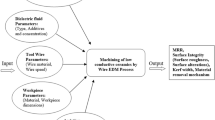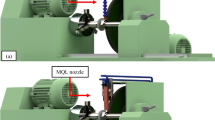Abstract
Increasing demand and resource overuse has prompted the exploration of spent secondary materials as a primary raw material for a variety of applications, leading to a more sustainable environment. Spent electric grid ceramic insulator, one of the waste materials of ceramic industry, has a good hardness and strength. It can be reused as value-added material in the Abrasive Water Jet Machining (AWJM) industry. The present work deals with the generation of cost-effective replacement material for abrasive water jet machining from electric insulator rejects (EIR). Mechanical crushing method is opted to generate the abrasive grit for the machining process. Grit generation pattern and the friability of the electric insulator rejects were determined experimentally. The results indicate that the friability of the processed electric insulator rejects is comparable with the commercially available garnet abrasive. Geometric parameters such as sphericity, elongation ratio, and shape factor for the processed electric insulator rejects were studied using scanning electron microscopy. The machining performance indicators for standard aluminium material such as volume of material removal, kerf angle, surface roughness, and cutting width were measured for electric insulator rejects and compared with existing garnet abrasive grain. The experimental results of the newly generated electric insulator reject abrasive were compared with the performance indicators of the garnet abrasive. The observed deviation was lower proving that it can be used as an alternative abrasive in the abrasive jet machining process. Cost analysis and recycling ability predict the economical usability of the newly generated abrasives.













Similar content being viewed by others
References
Abdel-Shafy HI, Mansour MS (2018) Solid waste issue: sources, composition, disposal, recycling, and valorization. Egypt. J Petrol 27(4):1275–1290
Ruiz LA, Ramón XR, Domingo SG (2020) The circular economy in the construction and demolition waste sector–a review and an integrative model approach. J Clean Prod 248: 119238
Jayasuriya A, Shibata ES, Chen T, Adams MP (2021) Development and statistical database analysis of hardened concrete properties made with recycled concrete aggregates. Resour Conserv Recy 164:105121
Zanelli C, Conte S, Molinari C, Soldati R, Dondi M (2020) Waste recycling in ceramic tiles: a technological outlook. Resour Conserv Recy 105289
Medina C, Frías M, De Rojas MS (2012) Microstructure and properties of recycled concretes using ceramic sanitary ware industry waste as coarse aggregate. Construct Build Mater 31:112–118
Vieira T, Alves A, De Brito J, Correia JR, Silva RV (2016) Durability-related performance of concrete containing fine recycled aggregates from crushed bricks and sanitary ware. Mater Des 90:767–776
El-Hofy M, Helmy MO, Escobar-Palafox G, Kerrigan K, Scaife R, El-Hofy H (2018) Abrasive water jet machining of multidirectional CFRP laminates. Procedia CIRP 68:535–540
Zhang Z, Yao P, Huang C, Wang J, Xue D, Deng W, Zhang Z (2019) Investigation and modeling of microgrooves generated on diamond grinding wheel by abrasive waterjet based on Box-Behnken experimental design. Int J Adv Manuf Technol 100(1–4):321–332
Olson D (2016) Industrial minerals review 2015. Min Eng 68(7):30
Aydin G, Kaya S, Karakurt I (2017) Utilization of solid-cutting waste of granite as an alternative abrasive in abrasive waterjet cutting of marble. J Clean Prod 159:241–247
Aydin G, Kaya S, Karakurt I (2019) Effect of abrasive type on marble cutting performance of abrasive waterjet. Arab J Geosci 12(11):357
Perec A, Pude F, Grigoryev A, Kaufeld M, Wegener K (2019) A study of wear on focusing tubes exposed to corundum-based abrasives in the waterjet cutting process. Int J Adv Manuf Technol 1–13
Balaji K, Kumar MS, Yuvaraj N (2021) Multi objective taguchi–grey relational analysis and krill herd algorithm approaches to investigate the parametric optimization in abrasive water jet drilling of stainless steel. Appl Soft Comput 102:107075
Sabarinathan P, Annamalai VE, Rajkumar K (2020) Sustainable application of grinding wheel waste as abrasive for abrasive water jet machining process. J Clean Prod 261:121225
Zhu Y, Lu W, Zuo D, Xiao H, Cao D, Ko TJ, Wu J, Yin Y (2019) Development of abrasive jet polishing by using amino thermosetting plastic abrasive for aluminum alloy. J Manuf Process 43:218–228
Thamizhvalavan P, Arivazhagan S, Yuvaraj N, Ramesh B (2019) Machinability study of abrasive aqua jet parameters on hybrid metal matrix composite. Mater Manuf Process 34(3):321–344
Wang T, Hou R, Lv Z (2017) Experimental investigation on the material removal of the ultrasonic vibration assisted abrasive water jet machining ceramics. Adv Mater Sci Eng Int J 1–6
Srinivas S, Babu NR (2012) Penetration ability of abrasive waterjets in cutting of aluminum-silicon carbide particulate metal matrix composites. Mach Sci Technol Int J 16(3):337–354
Cosansu G, Cogun C (2012) An investigation on use of colemanite powder as abrasive in abrasive waterjet cutting (AWJC). J Mech Sci Technol 26(8):2371–2380
Axinte DA, Srinivasu DS, Kong MC, Butler-Smith PW (2009) Abrasive waterjet cutting of polycrystalline diamond: a preliminary investigation. Int J Mach Tools Manuf 49(10):797–803
Khan AA, Haque MM (2007) Performance of different abrasive materials during abrasive water jet machining of glass. J Mater Process Technol 191(1–3):404–407
Babu MK, Chetty OK (2003) A study on recycling of abrasives in abrasive water jet machining. Wear 254(7–8):763–773
Llanto JM, Vafadar A, Aamir M, Tolouei-Rad M (2021a) Analysis and optimization of process parameters in abrasive waterjet contour cutting of AISI 304L. Metals 11(9):1362
Llanto JM, Tolouei-Rad M, Vafadar A, Aamir M (2021b) Impacts of traverse speed and material thickness on abrasive waterjet contour cutting of austenitic stainless steel AISI 304L. Appl Sci 11(11):4925
Llanto JM, Tolouei-Rad M, Vafadar A, Aamir M (2021c) Recent progress trend on abrasive waterjet cutting of metallic materials: a review. Appl Sci 11(8):3344
Aamir M, Tolouei-Rad M, Giasin K, Vafadar A (2020) Machinability of Al2024, Al6061, and Al5083 alloys using multi-hole simultaneous drilling approach. J Mater Res Technol 9(5):10991–11002
Natarajan Y, Murugesan PK, Mohan M, Khan SA (2020) Abrasive water jet machining process: a state of art of review. J Manuf Process 49:271–322
Cuhadaroglu AD, Kara E (2016) The investigation of breakage kinetics of vitrified sanitary ware wastes in laboratory scale ball and stirred mills. Part Sci Technol 34(1):9–16
Qu H, Wu X, Liu Y, Feng Y, Tang S, Zhang S, Hu Y (2020) Effect of shale mineralogy characteristics on the perforation performance and particle fragmentation of abrasive waterjet. Powder Technol 367:427–442
Xu S (2006) Modelling the cutting process and cutting performance in abrasive waterjet machining with controlled nozzle oscillation (Doctoral dissertation, Queensland University of Technology)
Alsoufi MS, Suker DK, Alhazmi MW, Azam S (2017) Influence of abrasive waterjet machining parameters on the surface texture quality of Carrara marble. J Surf Eng Mater Adv 7(2):25–37
Uthayakumar M, Khan A, Kumaran T, Slota A, Zajac J (2016) Machinability of nickel-based superalloy by abrasive water jet machining. Mater Manuf Process 31:1733–1739. https://doi.org/10.1080/10426914.2015.1103859
Boud F, Carpenter C, Folkes J, Shipway PH (2010) Abrasive waterjet cutting of a titanium alloy: the influence of abrasive morphology and mechanical properties on workpiece grit embedment and cut quality. J Mater Process Technol 210(15):2197–2205
Andrzej P (2018) Experimental research into alternative abrasive material for the abrasive water-jet cutting of titanium. Int J Adv Manuf Technol 97(1–4):1529–1540
Funding
The project was supported by the Ministry of Mines, Government of India, New Delhi for the funding support [Grant number- Met4-14/10/2019].
Author information
Authors and Affiliations
Contributions
P. Sabarinathan: conceptualization, investigation, writing — review & editing; K. Rajkumar: resources, supervision, & validation; V.E. Annamalai: data acquisition, visualisation, & project administration; K. Vishal: data acquisition and validation.
Corresponding author
Ethics declarations
Ethics approval
Not applicable.
Consent to participate
Not applicable.
Consent for publication
Not applicable.
Conflict of interest
The authors declare no competing interests.
Additional information
Publisher's Note
Springer Nature remains neutral with regard to jurisdictional claims in published maps and institutional affiliations.
Rights and permissions
About this article
Cite this article
Palaniyappan, S., Veiravan, A., Kaliyamoorthy, R. et al. Sustainable solution to low-cost alternative abrasive from electric ceramic insulator waste for use in abrasive water jet machining. Int J Adv Manuf Technol 120, 5243–5257 (2022). https://doi.org/10.1007/s00170-022-09077-4
Received:
Accepted:
Published:
Issue Date:
DOI: https://doi.org/10.1007/s00170-022-09077-4




